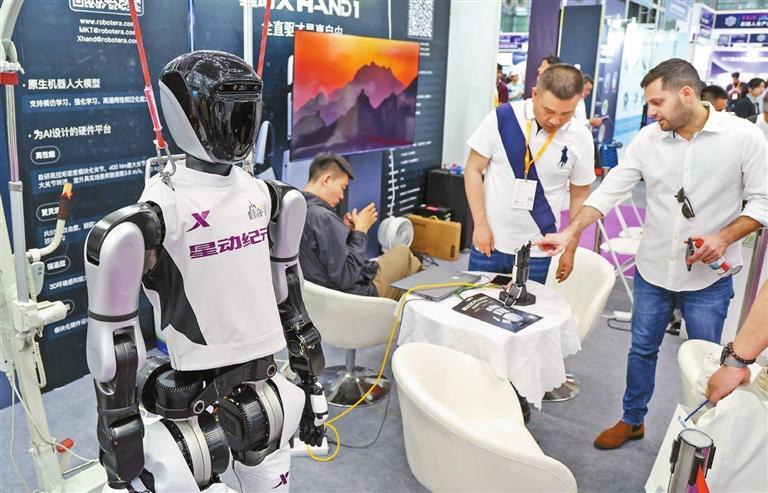
A robot plays the piano while visitors watch at FAIR plus 2025 at the Shenzhen Convention and Exhibition Center in Futian District on April 24.

Potential overseas buyers talk to an exhibitor at the expo.

A visitor interacts with Xialan, the humanoid robot developed by Digital Huaxia, at the expo at the Shenzhen Convention and Exhibition Center in Futian District on April 24.

A visitor consults a UBTECH employee at the company’s booth, where a Tien Kung Ultra robot was on display.

Dexterous robotic hands developed by Shenzhen’s Zhaowei are on display at the expo.
Shenzhen took another significant leap forward in its quest to become a global robotics powerhouse with the inaugural FAIR plus 2025 — the city’s largest robotics showcase to date, held at the Shenzhen Convention and Exhibition Center in Futian District on April 24.
Resembling a real-life “WALL-E” ensemble, the event brought together 180 robotics companies such as UBTECH, DJI-backed Unitree, and Leju Robotics, showcasing everything from industrial robotic arms to agile, terrain-conquering “robot dogs.”
A real-life ‘WALL-E’
FAIR plus 2025 provided a vivid demonstration of how robots are evolving from mere machines to companions and collaborators across various spheres of life and industry. The exhibition floor resembled a robotic carnival: humanoid robots playing the piano, collaborative robotic arms brewing coffee, high-jumping robot dogs, and even Mars-themed dancing robots thrilled visitors with their diverse skills.
UBTECH’s Tien Kung Ultra humanoid robot — fresh from winning the world’s first humanoid half-marathon — stole the spotlight by engaging the audience with dexterous hand gestures and interactions.
UBTECH introduced a newer version, dubbed “Tien Kung Walker 2.0,” a full-sized humanoid research robot priced under 300,000 yuan (US$43,000) — the first of its kind. Standing 172 cm tall with 20 degrees of freedom, this new version can navigate complex terrain such as hills, stairs, sand, and snow at speeds up to 10 km/h, according to UBTECH employees on site. With about 100 units already on pre-order, UBTECH aims to champion the trend toward more versatile and agile humanoid robots.
At a nearby booth, Digital Huaxia showcased its lifelike humanoid robot named “Xialan,” which is capable of mimicking a wide range of human facial expressions including happiness, anger, and sadness.
“While rivals focus on mobility, we’re perfecting emotional interaction,” said Chen Xiaonan, the company’s spokesperson.
Equipped with 29 degrees of freedom and crafted using durable biomimetic materials for a natural skin-like feel, these robots aim to revolutionize emotional companionship, Chen added.
The event also brought together a diverse range of upstream and downstream Shenzhen-based robotics enterprises vital to the industrial ecosystem — including Zhaowei Mechatronics, specializing in dexterous robotic hands; RoboSense, a leader in optical modules; Leadshine, developer of joint motors and reducers; and Orbbec, maker of advanced robotic vision systems. This highlighted the city’s ability to locally source 90% of robotics components.
Industry strength
Shenzhen’s robotics industry output surged beyond 200 billion yuan for the first time in 2024, reaching 201.2 billion yuan, an annual increase of 12.58%, according to a white paper released by the Shenzhen Institute of Advanced Technology and the Shenzhen Robotics Association on April 24.
The number of newly established robotics companies in 2024 also experienced robust growth — jumping 39.64% to 14,534 companies — reflecting intensified entrepreneurial enthusiasm and dynamism in the sector.
International interest was palpable at FAIR plus 2025. An Italian logistics firm expressed keen interest in Dobot Robotics’ industrial collaborative robotic arms, envisaging applications in automation and supply chain logistics.
Dobot’s regional manager, Chen Jianhong, highlighted that their industrial robotic arms have been widely adopted across sectors including electronics, automotive, and food manufacturing, with over 80,000 units shipped worldwide annually.
With a presence in more than 100 countries and regions, Dobot’s robotic arms have topped Chinese exports of similar products for seven consecutive years, Chen said.
A delegation from Germany’s VDMA (mechanical engineering industry association) marveled at the robots on display, praising the quality and innovation.
“Many overseas buyers think highly of Chinese consumer robots like vacuum cleaners and now are eager to learn more about humanoid robots here,” a VDMA representative said. Impressed by Shenzhen’s accelerated industrial chain capabilities, he noted, “What might take six months to a year elsewhere can be accomplished in one to two weeks here in Shenzhen.”
The ‘Robot Valley’ ecosystem
Beyond the expo, Shenzhen’s Robot Valley — a concentrated hub of robotics innovation in Nanshan District — is rapidly emerging as the industry’s epicenter. This belt-shaped area, home to top firms like UBTECH, DJI, and RoboSense, benefits from a tightly integrated supply chain where startups and established players collaborate seamlessly.
Dobot, which began as a small project in a local research incubator, credits its growth to Shenzhen’s ecosystem. “The supply chain here is unbeatable,” said founder Liu Peichao.
“Shenzhen’s ecosystem is the secret behind many local companies’ success. Ten years ago, I’d have quit without Shenzhen’s supply chain,” admitted Kenqing Technology CEO Yu Yunbo. Kenqing, founded in 2015, became an instant hit earlier this year after a video of tourists using its robotic exoskeletons to hike Taishan Mountain went viral.
Located across the Robot Valley, academic institutions like Southern University of Science and Technology and the Shenzhen Institutes of Advanced Technology fuel innovation through research partnerships.
At the wider ecosystem level, Shenzhen hosts over 2,267 artificial intelligence companies and 1,000 robotics firms. Talent hubs such as the Xili Lake Talent Service Center house more than 55 entrepreneurial teams, nurturing China’s next wave of robotics entrepreneurs and positioning the city at the forefront of what many believe will be a transformative global industry.



